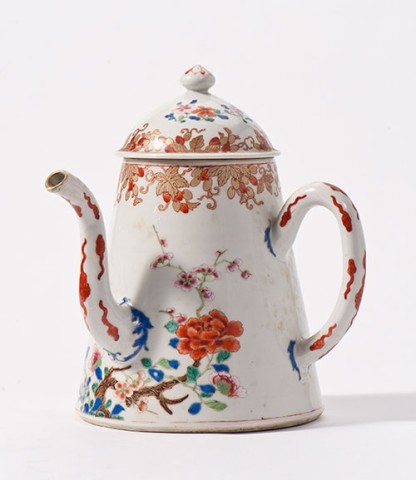Probably based on a European silver-model, the footring formed by the cylindrical sides that taper towards the top, with an S-shaped spout and an upright C-shaped handle set at 90 degrees to the spout, the round half-oviform, domed, flanged cover with a narrow flat rim and a round knob, all painted in bright famille rose and blue overglaze enamels and gilt-work, the body decorated with two gnarled branches in brown and gold, with blossoming and budding flowers in shades of iron-red, pink and green, surrounded by small leaves in clear blue and shades of green, the spout and the handle decorated with small iron-red cloud-motifs and clear blue scroll-work around the bases of both, the rim of the spout finished in gold, a finely drawn wine-leaf border extensively decorated in gold and iron-red detailing around the rim of the pot, this border mirrored on the cover on which further famille rose flower sprays are painted, the knob with a stylized flower-head, the base glazed.
Literature
For an almost identically shaped coffee-pot but decorated in blue and white and slightly smaller see D. F. Lunsingh Scheurleer, Chinese Export Porcelain: Chine de Commande, London, 1974, pl 194, where the author discusses the origins of coffee-pots of this shape: “At first, these were similar in shape to teapots, as is known by two silver pieces in the Victoria and Albert Museum. The teapot has a conical body and a short spout, whilst the oldest known silver coffee-pot [Charles II Domestic Silver (Victoria and Albert Museum), ill. 13] has the same shape with only one difference: the spout is not opposite to the handle but at right angles to it. Both models were copied in Chinese porcelain from the beginning of the 18th Century.”
Two other examples of this same shape but again slightly smaller, one in Chinese Imari, the other in famille rose are in the Groninger Museum, Holland, illustrated in Ceramics Crossed Overseas: Jingdezhen, Imari and Delft from the Collection of the Groninger Museum / C.J.A. Jörg et al., Tokyo 1999, no. 73 and no. 86.
An early English silver example in a similar shape to ours but even taller is in the Victoria and Albert Museum, museum no M.399-1921. It was commissioned by George Berkeley in 1670 to be presented to the East India Company, with which he had close links, being married to the daughter of its treasurer, having significant investments in the company and in 1681 as a member. The notably large size (height 33.75 cm) of this example is appropriate to a pot that was intended to serve the numerous members of the East India Company committee.

